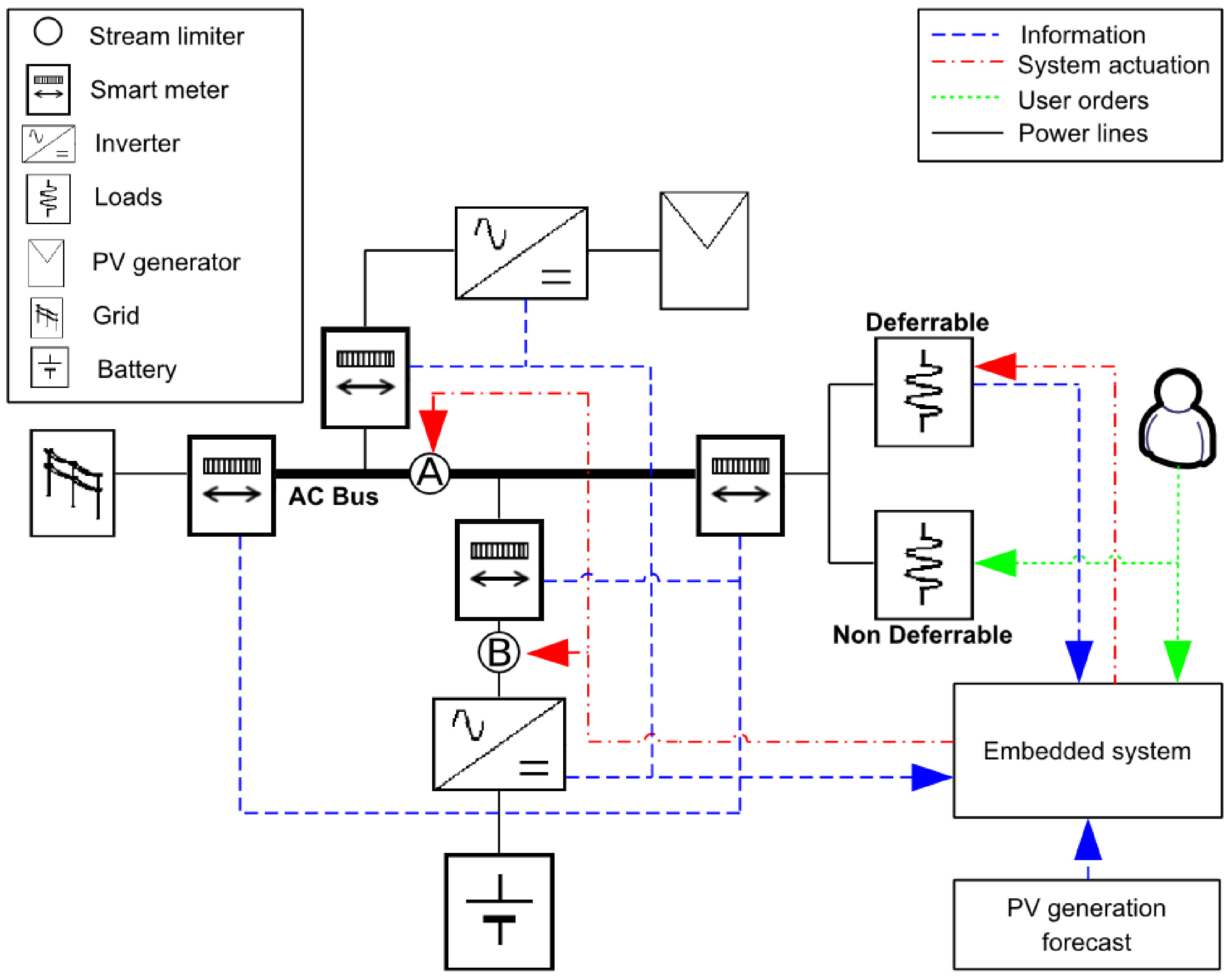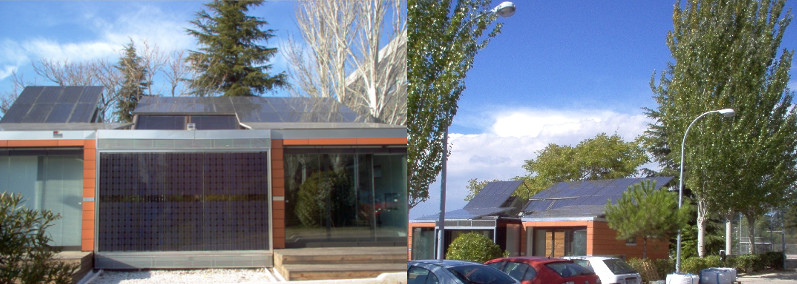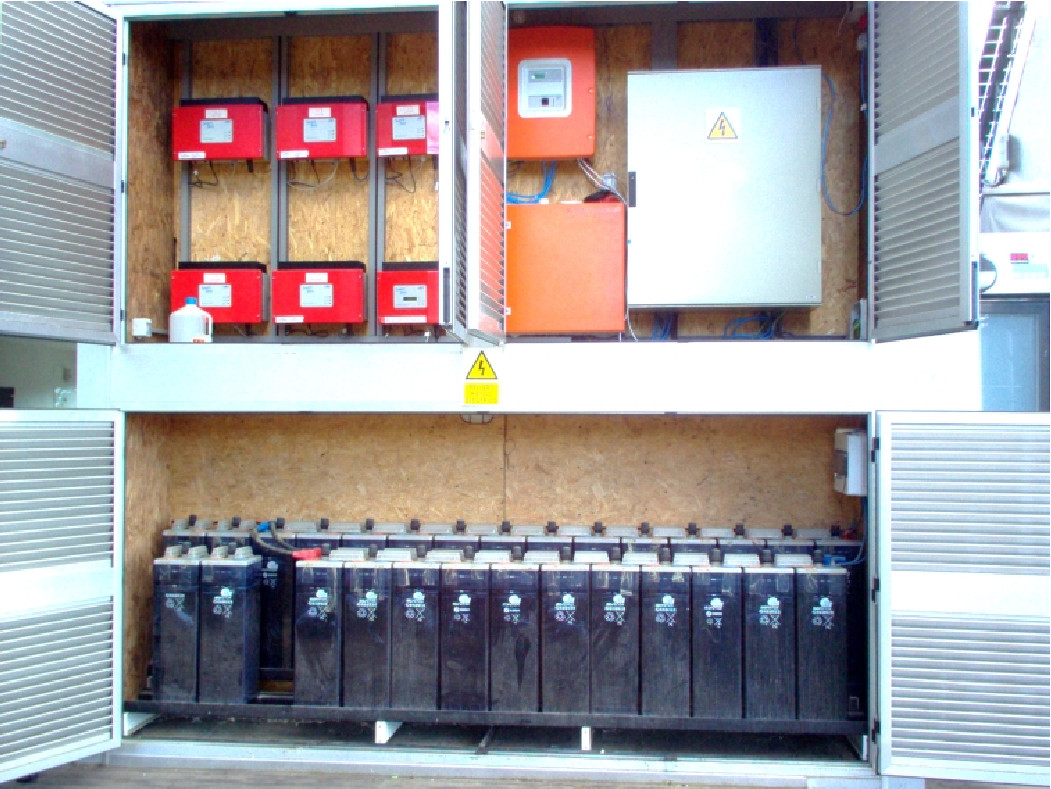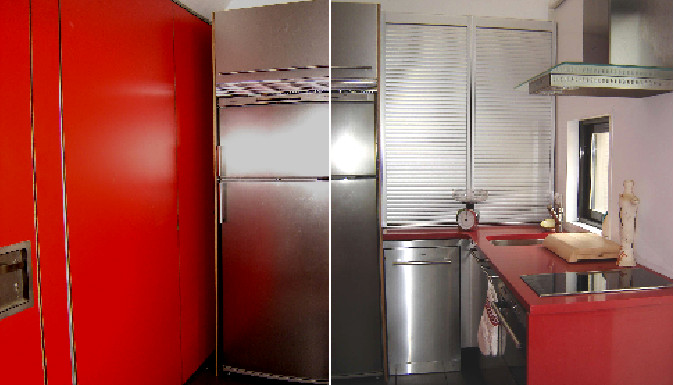MagicBox is an energy self-sufficient solar house located at the Escuela Técnica Superior de Ingenieros de Telecomunicación (ETSIT) of the Universidad Politécnica de Madrid (UPM). It combines bioclimatic design principles, PV solar energy integration, local energy storage technology and the use of Information and Communication Technologies (ICTs) to monitor and control the house power flow.
MagicBox was originally designed to participate in the Solar Decathlon 2005 contest, being the first house from an European university to take part in this event. Solar Decathlon is an award-winning program that challenges collegiate teams to design, build, and operate solar-powered houses that are cost-effective, energy-efficient, and attractive design. After finishing the competition, MagicBox was installed at the ETSIT under the Heliodomo project framework. This house hosted the R&D project GeDELOS-FV that early studied the integration of PV hybrid and load control technologies in order to explore the possibilities of self-consumption using PV technology, local storage and controllable consumption in the residential sector. MagicBox also hosted the project VE2 whose main objective is the development of a software platform to manage the interaction of electric vehicles parked and connected to the electric grid of a building and the electric consumption of the whole building.
MagicBox is currently used as a research laboratory to assess the effect of the combination of PV generation, load management and local storage on the electrical grids. From the electrical point of view, its structure is based on an AC bus topology. It works on 230V and 50Hz because of Spanish grid connection. From an ICT point of view, an embedded system receives information from the elements of the house (generation, storage and loads) and operates as a user interface. This embedded system can also actuate over some elements of the house to control their power flows. An schematic of the electricity and communication network of the house is shown in the next figure.

PV generator: The PV generation system of MagicBox consists of five independent monocrystalline silicon PV fields with 5.55kWp of total generation. This system is set in order to exploit the different tilts of the sun along the year within the operational strategies of the house. To achieve this goal, the fields are distributed in different south-oriented surfaces: 1.45kWp at 12º, 2.7kWp at 25º, 0.8kWp at 39º and 0.6kWp at 90º. Each PV field has an associated string-type inverter. The photovoltaic system is equipped with a forecast PV generation module that communicates with the embedded system. This system calculates hourly forecasts of irradiation and ambient temperature for the next day. These variables are estimated for Madrid (40.5ºN, 3.7ºW), where MagicBox is located. From these meteorological forecasts, the usable electricity from the PV generators is estimated taking into account site-dependent (i.e. shadowing) and technological (PV modules, inverters, battery, etc.) characteristics of MagicBox. Therefore, the PV generation profile is available for the next 24 hours.

Storage system: The house is equipped with a lead-acid battery stationary bank. The battery bank is divided in 24 cells, each cell has a capacity of 750Ah and a voltage of 2V. Therefore, the total battery bank voltage is 48V with a capacity around 36kWh. The storage system has a bidirectional battery inverter because the battery operates at DC and all energy exchanges are produced through the AC bus. The battery inverter does not only implement the current conversion, but allows controlling the power flows in the house. This control is implemented through two stream limiters. Thanks to these limiters, high-level software battery controllers can be developed to fulfill different strategies. The limiter A regulates the power flow between the possible generation sources and the consumption and storage. Through this limiter, the local consumption can be isolated from the grid. The limiter B regulates the battery charge power.

Consumption: The house includes typical electrical appliances of a highly electrified house. The fixed appliances are monitored but not controlled: cooking appliances, fridge, freezer, lighting, computers and entertainment appliances. There are also three deferrable appliances: washing machine, dishwasher and dryer. The deferrable loads are integrated in a home automation system which allows the appliances to be monitored and controlled by a remote system. The communication of the home automation system is based on a Power Line Communication (PLC) network.

Manuel Castillo-Cagigal. A swarm intelligence approach based on coupled oscillators: an application in demand side management with photovoltaic distributed generation. Universidad Politécnica de Madrid. December 2014. [link]
Daniel Masa-Bote, Manuel Castillo-Cagigal, Eduardo Matallanas, Estefanía Caamaño-Martín, Álvaro Gutiérrez, Félix Monasterio-Huelin and Javier Jiménez-Leube. Improving photovoltaics grid integration through short time forecasting and self-consumption. Applied Energy, 125, pages 103-113, July 2014, ISSN: 0306-2619, IF: 5.261. doi: 10.1016/j.apenergy.2014.03.045. [link]
Eduardo Matallanas, Manuel Castillo-Cagigal, Álvaro Gutiérrez, Félix Monasterio-Huelin, Estefanía Caamaño-Martín, Daniel Masa and Javier Jiménez-Leube. Neural Network Controller for Active Demand Side Management with PV Energy in the Residential Sector. Applied Energy , 91(1), pages 90-97, March 2012, ISSN: 0306-2619, IF: 4.781. Highly Cited Research Paper 2012 to 2013 Award. [link]
Manuel Castillo-Cagigal, Eduardo Matallanas, Álvaro Gutiérrez, Félix Monasterio-Huelin, Estefanía Caamaño-Martín, Daniel Masa and Javier Jiménez-Leube. Heterogeneous Collaborative Sensor Network for Electrical Management of an Automated House with PV Energy. Sensors, 11(12), pages 11544-11559. December 2011. ISSN: 1424-8220, IF: 1.739. [link]
Manuel Castillo-Cagigal, Estefanía Caamaño-Martín, Eduardo Matallanas, Daniel Masa-Bote, Álvaro Gutiérrez, Félix Monasterio-Huelin, Javier Jiménez-Leube. PV self-consumption optimization with storage and Active DSM for the residential sector. Solar Energy, 85(9), pages 2338-2348, September 2011, ISSN: 0038-092X, IF: 2.475. [link]
Eduardo Matallanas, Manuel Castillo-Cagigal, Estefanía Caamaño-Martín, Daniel Masa-Bote, Álvaro Gutiérrez and Félix Monasterio-Huelin. Analysis of the Self-Consumption Possibilities in Small Grid-Connected Photovoltaic Systems in Spain. 26th European Photovoltaic Solar Energy Conference. September 2011, WIP-Renewable Energies, Munich, Germany, pages 4619-4624.
Manuel Castillo-Cagigal, Álvaro Gutiérrez, Félix Monasterio-Huelin, Estefanía Caamaño, Daniel Masa, Javier Jiménez-Leube. A Semi-Distributed Electric Demand-Side Management System with PV Generation for Self-Consumption Enhancement. Energy Conversion and Management 52(7), pages 2659-2666, July 2011, ISSN: 0196-8904, IF: 2.216. [link]
Manuel Castillo-Cagigal, Eduardo Matallanas, Daniel Masa-Bote, Estefanía Caamaño-Martín, Álvaro Gutiérrez, Félix Monasterio-Huelin and Javier Jiménez-Leube. Self-consumption enhancement with storage system and demand-side management: GeDELOS-PV system. 5th International Renewable Energy Storage Conference (IRES 2010). November 2010, EUROSOLAR, Bonn, Germany.
Estefanía Caamaño-Martín, Manuel Castillo-Cagigal, Daniel Masa-Bote, Álvaro Gutiérrez, Eduardo Matallanas, Félix Monasterio-Huelin and Javier Jiménez-Leube. Autoconsumo de Energía Solar Fotovoltaica con Gestión Activa de la Demanda: El Sistema GeDELOS-FV. IV Conferencia Latinoamericana de Energía Solar (IV ISES CLA) y XVII Simposio Peruano de Energía Solar (XVII- SPES). November 2010, Asociación Peruana de Energía Solar y del Ambiente, Cuzco, Perú.
Manuel Castillo-Cagigal, Estefanía Caamaño-Martín, Álvaro Gutiérrez, Daniel Masa-Bote, Félix Monasterio-Huelin, Jorge Porro, Eduardo Matallanas and Javier Jiménez-Leube. Self-Consumption of PV Electricity with Active Demand Side Management: the GeDELOS-PV System. 25th European Photovoltaic Solar Energy Conference/5th World Conference on Photovoltaic Energy Conversion. September 2010, WIP-Renewable Energies, Munich, Germany, pages 4866-4870. ISBN: 3-936338-26-4.
Estefanía Caamaño-Martín, Daniel Masa, Álvaro Gutiérrez, Félix Monasterio-Huelin, Javier Jiménez-Leube, Jorge Porro y Manuel Castillo-Cagigal. Optimización del Uso de un Sistema Fotovoltaico Mediante Gestión Activa de la Demanda. I Congreso de Generación Distribuida. November 2009, Fundación de la Energía de la Comunidad de Madrid, Madrid, Spain, pages 121-126. ISBN: 978-84-613-6375-9.
Manuel Castillo-Cagigal, Álvaro Gutiérrez, Félix Monasterio-Huelin, Daniel Masa, Estefanía Caamaño-Martín, Javier Jiménez-Leube and Jorge Porro. Sistema de Control Distribuido para la Gestión de la Demanda en el Sector Residencial. I Congreso de Generación Distribuida. November 2009, Fundación de la Energía de la Comunidad de Madrid, Madrid, Spain, pages 275-280. ISBN: 978-84-613-6375-9.
Estefanía Caamaño-Martín, Daniel Masa, Álvaro Gutiérrez, Félix Monasterio-Huelin, Manuel Castillo-Cagigal, Javier Jiménez-Leube and Jorge Porro. Optimizing PV use through active demand side management. 24th European Photovoltaic Solar Energy Conference, September 2009, WIP-Renewable Energies, Munich, Germany, pages 3149-3155. ISBN: 3-936338-25-6.
E. Caamaño-Martín, M. A. Egido, J. Neila, C. Bedoya, A. G. Santos, F. J. Jiménez, and L. Magadalena. Spanish participation in the "Solar Decathlon 2005" competition: new proposal for zero-energy houses. In Proceedings of the 20th European Photovoltaic Solar Energy Conference, September 2005, pages 2587–2590, Munich, Germany. WIP-Renewable Energies.
M. Calvo-Fernández, J. E. Vega, M. A. Egido and E. Caamaño-Martín. Spanish participation in the “Solar Decathlon 2005” competition: design and simulation of the photovoltaic system. In Proceedings of the 20th European Photovoltaic Solar Energy Conference, September 2005, pages 1958–1963, Munich, Germany. WIP-Renewable Energies.